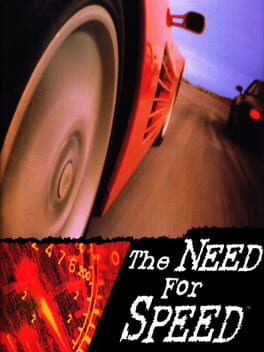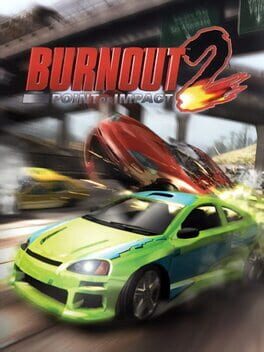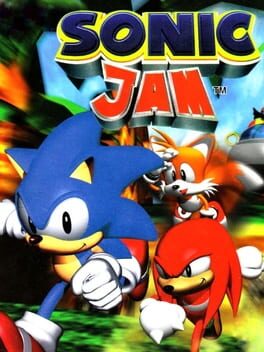prism
Bio
Nothing here!
Badges

1 Years of Service
Being part of the Backloggd community for 1 year

Elite Gamer
Played 500+ games

Gamer
Played 250+ games

N00b
Played 100+ games
771
Total Games Played
000
Played in 2024
482
Games Backloggd
Recently Reviewed See More
Played both the 3DO and PlayStation 1 versions of the game an equal amount (roughly an hour and a half's worth each, making 3 hours total!).
I’ve considered Need For Speed to be one of the racing greats, so I figured I would check in on some of the earlier entries I had never played, beginning with the first entry.
It is definitely a first-game syndrome title. The presentation is cheesy enough (I love my corny dated FMVs!) but ultimately has little content to bring it out of being nothing more than a demo.
The most the game provides you with is a couple of cars of which have practically no customization at all (though there is a section that contains precise vehicle data for each car with spoken commentary and short video clips highlighting the vehicles set to music which is likely where the Road & Track collaboration came in – the only time they were ever involved in the NFS series) and six courses in the game (though the 3DO version, having been released two years prior to the PS1 version, only has three).
The moment you get into the game, the visuals are the first thing to note. There have been much better looking racers on the PS1, but it winds up being a relatively pretty game – for the 3DO. Despite this, the scenic tracks wind up looking rather devoid of life save for the occasional traffic on the road. Other titles accommodated this by introducing vertex coloring for the tracks to infuse that bit more oomph, and I’m surprised that this was not considered for the PS1 version at the minimum.
You can choose the time of day but I’ve found this to not really be anything noticeable, they for the most part switch out the skybox here. The music (composed by Jeff Dyck, Saki Kaskas and Alistair Hirst according to the credits) is nothing worth honing on about either, as it winds up fitting the standard generic rock tracks that often plagued racers around this period.
The worst thing about this game, unfortunately, is the controls and the track design. Even if you select the automatic transmission for your car in the main menu prior to racing, you still have to shift to the first gear by hitting the R1 button to even start moving. Every race starts you with the cockpit view, which can be changed with the press of the triangle button, but I’d recommend sticking to the cockpit view anyways since these controls clearly cater to this view.
The steering is shockingly stiff for a game like this, especially since the PS1 version includes brand new closed-circuit tracks which require a fair bit of turning. The point-to-point tracks are a less painful way to play, though turns are still expected so it remains uncomfortable to get used to the controls.
The point-to-point tracks also feature traffic! It sucks! The moment your car collides with traffic (and it will happen given the unwieldy controls), you will lose control of your car and watch it fling itself against walls and other cars. In a race against several CPU players, this is a death sentence towards ever achieving a top position in the race which winds up making the game feel more frustrating to play rather than a fun experience.
Point-to-point tracks also feature cop pursuits, which is either a situation that ends prematurely because you’re driving so fast that the cop quite literally despawns, or it ends prematurely because you’ve crashed into so much stuff that the cop has instantly caught up with you. When a cop catches up to you, they will pull you over and issue a speeding ticket. Three strikes and your game’s over (though I’ve heard the Saturn version is even more strict with two strikes!), which is not uncommon knowing this game.
In conclusion, this is a game that I would only ever peek into as a curiosity over how the NFS series started. As an individual title, it ages in comparison to its contemporaries and it ages in comparison to future titles, both within its series and outside, that did the things this game set out to do in a much better format.
I’ve considered Need For Speed to be one of the racing greats, so I figured I would check in on some of the earlier entries I had never played, beginning with the first entry.
It is definitely a first-game syndrome title. The presentation is cheesy enough (I love my corny dated FMVs!) but ultimately has little content to bring it out of being nothing more than a demo.
The most the game provides you with is a couple of cars of which have practically no customization at all (though there is a section that contains precise vehicle data for each car with spoken commentary and short video clips highlighting the vehicles set to music which is likely where the Road & Track collaboration came in – the only time they were ever involved in the NFS series) and six courses in the game (though the 3DO version, having been released two years prior to the PS1 version, only has three).
The moment you get into the game, the visuals are the first thing to note. There have been much better looking racers on the PS1, but it winds up being a relatively pretty game – for the 3DO. Despite this, the scenic tracks wind up looking rather devoid of life save for the occasional traffic on the road. Other titles accommodated this by introducing vertex coloring for the tracks to infuse that bit more oomph, and I’m surprised that this was not considered for the PS1 version at the minimum.
You can choose the time of day but I’ve found this to not really be anything noticeable, they for the most part switch out the skybox here. The music (composed by Jeff Dyck, Saki Kaskas and Alistair Hirst according to the credits) is nothing worth honing on about either, as it winds up fitting the standard generic rock tracks that often plagued racers around this period.
The worst thing about this game, unfortunately, is the controls and the track design. Even if you select the automatic transmission for your car in the main menu prior to racing, you still have to shift to the first gear by hitting the R1 button to even start moving. Every race starts you with the cockpit view, which can be changed with the press of the triangle button, but I’d recommend sticking to the cockpit view anyways since these controls clearly cater to this view.
The steering is shockingly stiff for a game like this, especially since the PS1 version includes brand new closed-circuit tracks which require a fair bit of turning. The point-to-point tracks are a less painful way to play, though turns are still expected so it remains uncomfortable to get used to the controls.
The point-to-point tracks also feature traffic! It sucks! The moment your car collides with traffic (and it will happen given the unwieldy controls), you will lose control of your car and watch it fling itself against walls and other cars. In a race against several CPU players, this is a death sentence towards ever achieving a top position in the race which winds up making the game feel more frustrating to play rather than a fun experience.
Point-to-point tracks also feature cop pursuits, which is either a situation that ends prematurely because you’re driving so fast that the cop quite literally despawns, or it ends prematurely because you’ve crashed into so much stuff that the cop has instantly caught up with you. When a cop catches up to you, they will pull you over and issue a speeding ticket. Three strikes and your game’s over (though I’ve heard the Saturn version is even more strict with two strikes!), which is not uncommon knowing this game.
In conclusion, this is a game that I would only ever peek into as a curiosity over how the NFS series started. As an individual title, it ages in comparison to its contemporaries and it ages in comparison to future titles, both within its series and outside, that did the things this game set out to do in a much better format.
Burnout 2 is a big jump in quality from the first game, and it’s safe to say that it only ever gets better from here on out.
Much of the original game’s foundation is still at the core of Burnout 2, but it is tightly polished. The controls and hitboxes have seen a substantial overhaul, which makes it feel more in line with later Burnout entries, which is what I have been used to. It also means that you will not crash from simply scrapping your car against another, most crashes in this game will absolutely be your fault as they only usually trigger if you hit the car directly.
The gameplay loop, a carryover from Burnout 1, is made more fun because of how quick and easy it is to fill the burnout meter, though there still isn't an onscreen effect when boosting yet. The burnout bonus from the first game is not only retained but has a visual in the HUD to indicate that you can chain your boosts once it depletes which helps fit within the tone of the game. If you play your cards correctly you can chain those suckers for a long period of time and in doing so you’ll feel on top of the world. The HUD itself is almost identical to the original but there are nice additions and QOL improvements. For instance, there is now an indicator pertaining to how far behind (or ahead) your opponents are every time you reach a checkpoint.
Two things that stand out in Burnout 2 are the brand-new Hot Pursuit style missions and of course, the Crash events making their debut here. The crash events are much more simplistic compared to Burnout 3 (no aftertouch or crashbreakers yet, just pure skill) but still a lot of fun. There’s also a great soundtrack composed by Stephen Root & Steve Emney, which already distinguishes itself over the original game. The music in Burnout 1 was the most “racing game” sounding music ever, and Burnout 2 addresses this by presenting variety whilst maintaining the dynamic nature that the original game attempted to accomplish.
It’s good to check back into the origins of specific franchises because you can either find something that noticeably needed improvement, or a relatively well-hidden gem. I consider Burnout 2 to be the latter. It’s no Burnout 3, but it wears the arcade racing experience on its sleeve very well, and it is the last game to really incorporate that formula as Burnout 3 would come in and overhaul just about everything!
Much of the original game’s foundation is still at the core of Burnout 2, but it is tightly polished. The controls and hitboxes have seen a substantial overhaul, which makes it feel more in line with later Burnout entries, which is what I have been used to. It also means that you will not crash from simply scrapping your car against another, most crashes in this game will absolutely be your fault as they only usually trigger if you hit the car directly.
The gameplay loop, a carryover from Burnout 1, is made more fun because of how quick and easy it is to fill the burnout meter, though there still isn't an onscreen effect when boosting yet. The burnout bonus from the first game is not only retained but has a visual in the HUD to indicate that you can chain your boosts once it depletes which helps fit within the tone of the game. If you play your cards correctly you can chain those suckers for a long period of time and in doing so you’ll feel on top of the world. The HUD itself is almost identical to the original but there are nice additions and QOL improvements. For instance, there is now an indicator pertaining to how far behind (or ahead) your opponents are every time you reach a checkpoint.
Two things that stand out in Burnout 2 are the brand-new Hot Pursuit style missions and of course, the Crash events making their debut here. The crash events are much more simplistic compared to Burnout 3 (no aftertouch or crashbreakers yet, just pure skill) but still a lot of fun. There’s also a great soundtrack composed by Stephen Root & Steve Emney, which already distinguishes itself over the original game. The music in Burnout 1 was the most “racing game” sounding music ever, and Burnout 2 addresses this by presenting variety whilst maintaining the dynamic nature that the original game attempted to accomplish.
It’s good to check back into the origins of specific franchises because you can either find something that noticeably needed improvement, or a relatively well-hidden gem. I consider Burnout 2 to be the latter. It’s no Burnout 3, but it wears the arcade racing experience on its sleeve very well, and it is the last game to really incorporate that formula as Burnout 3 would come in and overhaul just about everything!
I have seen lots of complaints pertaining to specific Sonic games over my time playing them. Some say that 06 is the worst, or that one Labyrinth spinoff is bad. They are all wrong: nothing compares to this specific Sonic title.
Sonic Jam on the Tiger game.com is an incredibly barebones and barely operational Sonic game that isn’t even a “compilation” like its Saturn counterpart. You get 3 “games” in total: Sonic 2, Sonic 3 and Sonic & Knuckles. Note the usage of quotes on “games”, as in reality each game has one zone spread across a tedious four acts. 2 gets Emerald Hill, 3 gets Angel Island and S&K gets Mushroom Hill.
The “Sonic World” overworld present in the Saturn counterpart is outright missing here, and so is Sonic 1. Sonic 3D Blast, present in pre-release material for this game, is also not here. Must have either been a time related exclusion, or a quality assurance thing. Would be hilarious if the latter.
What does not help matters is the fact that not only is the game.com hardware clearly having trouble running the game in the first place, but controls are wonky and certain characters cannot clear specific levels. Sonic and Knuckles can not get up the Angel Island tree sequence, it is outright bugged in this version. If you don’t know this, then you’ll find out the hard way by repeatedly trying to run up it.
Tails is the only one capable of bypassing this sequence by virtue of Tails having flight (though busted in comparison to even the Mega Drive original). Knuckles doesn’t even have his gliding or climbing abilities from the Mega Drive original, he is practically just a skin of Sonic himself. If you want to actually play through the game in its entirety, then you are effectively forced into playing as Tails.
Visuals are awful and are reminiscent of those unofficial Game Boy Sonic bootlegs, and the sound doesn’t fare much better either. There is zone music present in the game but because of the hardware it’s slowed down to an outright crawl; it sounds like incoherent beeps and boops.
There are special stages in this game but they are not mandatory to beat the game. Literally. It doesn’t even matter. The special stages themselves are the same ones present in Sonic 3 & Knuckles, being Blue Spheres (albeit hardware limitations make them look more like Black Spheres). I only ever got to these once, then never bothered reaching them again.
Unless you’re scraping the bottom of the barrel for Sonic games to play, don’t bother touching this one. I wouldn’t even recommend playing this. Play the Saturn counterpart, or any Sonic compilation to get a better experience.
Sonic Jam on the Tiger game.com is an incredibly barebones and barely operational Sonic game that isn’t even a “compilation” like its Saturn counterpart. You get 3 “games” in total: Sonic 2, Sonic 3 and Sonic & Knuckles. Note the usage of quotes on “games”, as in reality each game has one zone spread across a tedious four acts. 2 gets Emerald Hill, 3 gets Angel Island and S&K gets Mushroom Hill.
The “Sonic World” overworld present in the Saturn counterpart is outright missing here, and so is Sonic 1. Sonic 3D Blast, present in pre-release material for this game, is also not here. Must have either been a time related exclusion, or a quality assurance thing. Would be hilarious if the latter.
What does not help matters is the fact that not only is the game.com hardware clearly having trouble running the game in the first place, but controls are wonky and certain characters cannot clear specific levels. Sonic and Knuckles can not get up the Angel Island tree sequence, it is outright bugged in this version. If you don’t know this, then you’ll find out the hard way by repeatedly trying to run up it.
Tails is the only one capable of bypassing this sequence by virtue of Tails having flight (though busted in comparison to even the Mega Drive original). Knuckles doesn’t even have his gliding or climbing abilities from the Mega Drive original, he is practically just a skin of Sonic himself. If you want to actually play through the game in its entirety, then you are effectively forced into playing as Tails.
Visuals are awful and are reminiscent of those unofficial Game Boy Sonic bootlegs, and the sound doesn’t fare much better either. There is zone music present in the game but because of the hardware it’s slowed down to an outright crawl; it sounds like incoherent beeps and boops.
There are special stages in this game but they are not mandatory to beat the game. Literally. It doesn’t even matter. The special stages themselves are the same ones present in Sonic 3 & Knuckles, being Blue Spheres (albeit hardware limitations make them look more like Black Spheres). I only ever got to these once, then never bothered reaching them again.
Unless you’re scraping the bottom of the barrel for Sonic games to play, don’t bother touching this one. I wouldn’t even recommend playing this. Play the Saturn counterpart, or any Sonic compilation to get a better experience.


